Golf Digest - 30 Greatest Canadian
Bold = Played as of 12/31/12
Link = Reviewed as of 12/31/12
1. The National GC of Canada
2. St George's G&CC
3. Capilano G&CC
4. Hamilton G&CC (West/South)
5. Jasper Park Lodge
6. Shaughnessy G&CC
7. Highlands Links GC
8. Banff Springs GC
9. Cabot Links
10. Devil's Paintbrush
11. Devil's Pulpit
12. Muskoka Bay Club
13. Redtail GC
14. Beacon Hall GC
15. Dakota Dunes GL
16. Sagebrush G&SC
17. Westmount
18. Royal Montreal (Blue)
19. The Links at Crowbush Cove
20. Georgian Bay Club
21. Coppinwood
22. Bigwin Island GC
23. Mississaugua G&CC
24. Eagles Nest GC
25. The Ridge at Manitou
26. Toronto GC
27. Tobiano
28. Big Sky G&CC
29. Brudenell River GC
30. Black Bear Ridge
Total 21/30 Played
Friday, December 28, 2012
Tuesday, December 25, 2012
Streamsong Resort (Blue), Streamsong, Florida - Course Review
Streamsong Resort (Blue)
Streamsong, Florida, United States
Architect: Tom Doak (2012)
7,176 Yards, Par-72
Rating/Slope: 74.1/131
My Quick Review: Destined for top-100 world.
Tom Doak's Blue Course at Streamsong Resort is exceptional. From the first tee to the final putt, the golfer is challenged to think his way around the golf course as the direct line is rarely the ideal play. The Coore & Crenshaw Red Course is routed through larger dunes and more prevalent water hazards, perhaps making it a slightly more complicated site, but it is Doak's routing that is the more comfortable one. Doak's routing is near flawless with very short green to tee walks, constant changes in direction, and an ability to move the golfer up and down elevation with ease. The 1st tee, sited at the top of a 60 foot high (?) dune is something of a curious decision, but as Doak noted in an earlier thread the additional length was needed to prevent golfers from waiting for the first green to clear. And, the view is exceptional. The other curiosity is the decision to route the par-3 7th such that the golfer walks to the green and near back to the tee.
Tie-ins on both golf courses are perfect. Transitions from green to fairway to bunker to sandy waste area to dunes to native grasses to water hazards are so natural that one wonders whether these golf courses have been here forever.
Bunker shaping will be familiar to fans of Doak and/or Coore & Crenshaw.
Doak's greens drape perfectly on the land. There is a convexity to the undulations on some greens that is unlike anything I have ever seen before. On the Red Course, bold and broad internal contours will have misplayed shots roll slowly and steadily away from their targets. On the Blue Course, shots landing on the wrong part of the green, especially if from the wrong angle will be propelled in directions the golfer had not considered. The Red Course is overt in its penalties, the blue course subtle; but I'm not convinced the Blue Course is any easier.
Scorecard Information
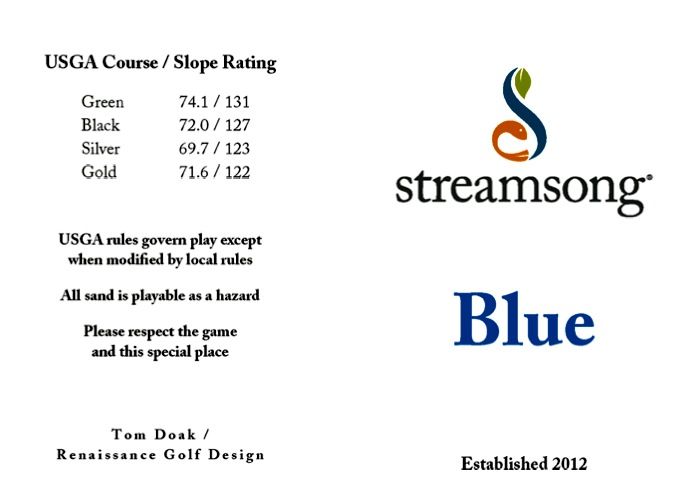

Unlike the 470 yard behemoth of a par-4 on the Red, Doak eases the golfer into the round, offering the opportunity to hit less than driver from the elevated first tee. The width of the 1st fairway is probably 40 yards at its narrowest, and where the option to bailout right is available, the fairway widens to about 100 yards.

Golfers on the 1st tee help to give a sense of scale.

Aggressive tee shots down the centre/left will be rewarded with a simple pitch. Approaching from the right, though from the fairway, is a difficult task requiring a blind approach over a dune to a green that falls off on the left.

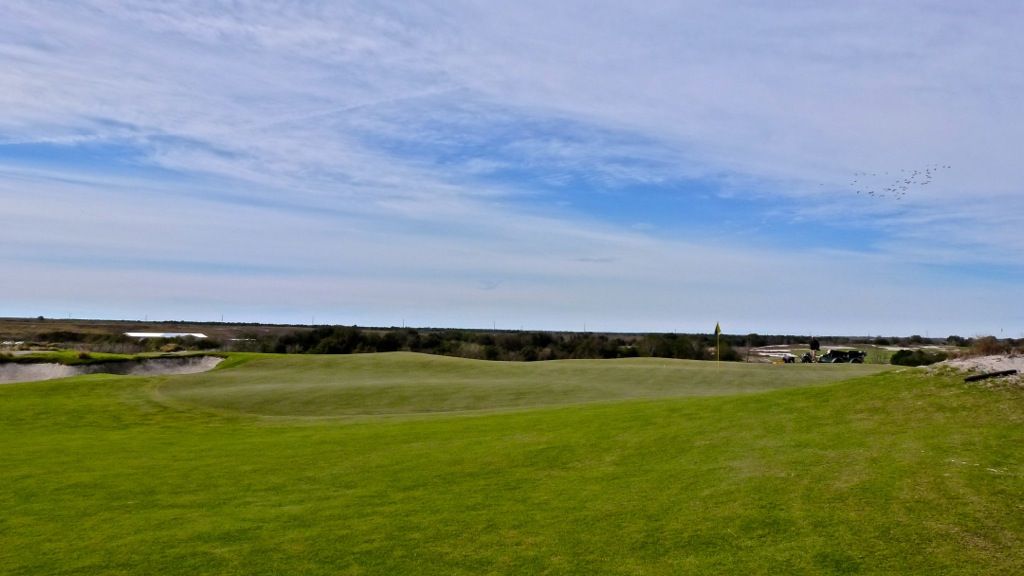
The second is a 550 yard par-5 and golfers long enough to reach this green in two will want to carry the fairway bunker (270 yards) to find a speed-slot.

Along with the 2nd shot on the par-5 9th, the 2nd shot here is one of the two dullest on the course. Those laying-up are presented with ample fairway and no obvious reason to aim anywhere but the centre. Much of the green is hidden from view behind the left bunker, though it is a miss to the right that will cause the real trouble.
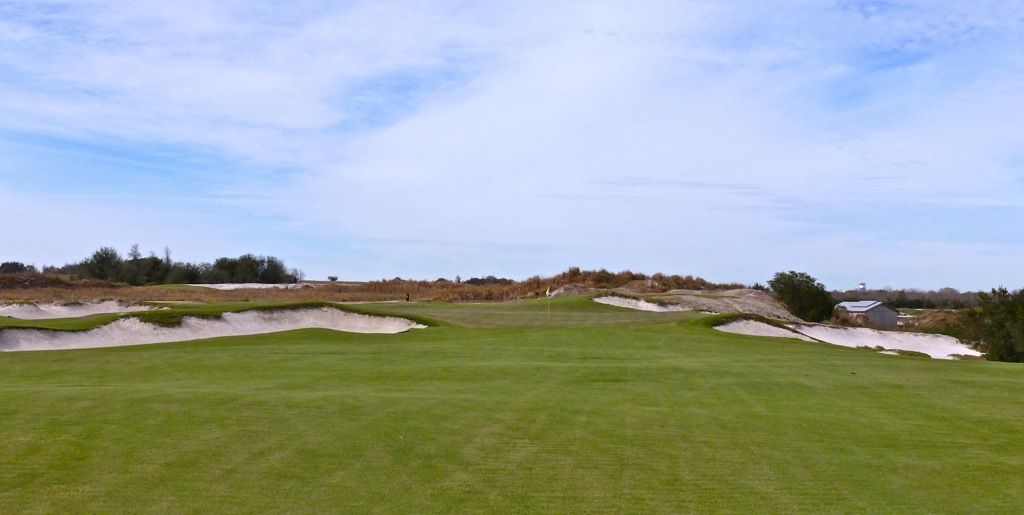

The third hole starts a tremendous stretch of golf. A green set boldly on a plateau is in view from the tee and begs the golfer to play near the hazard line.
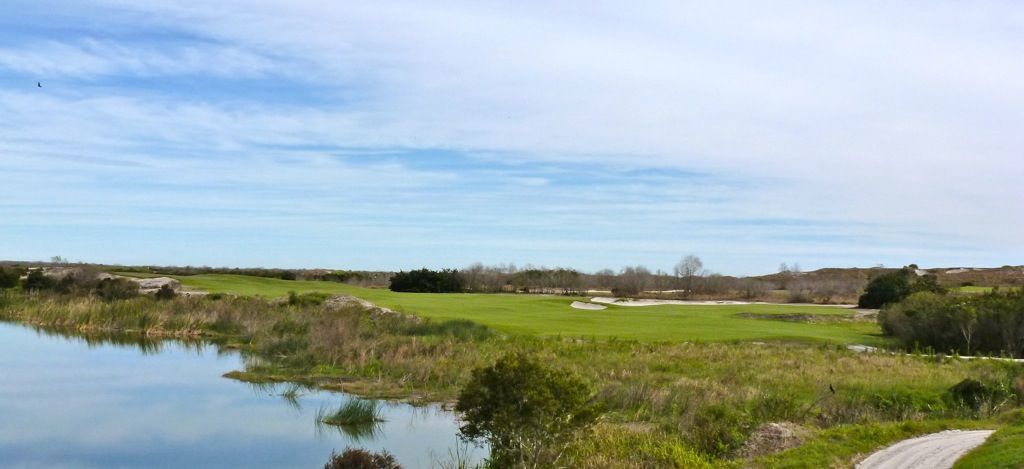
A bold tee shot up the left leaves a simple approach to a blind putting surface though shots missing the plateau right will run a very long way from the hole.
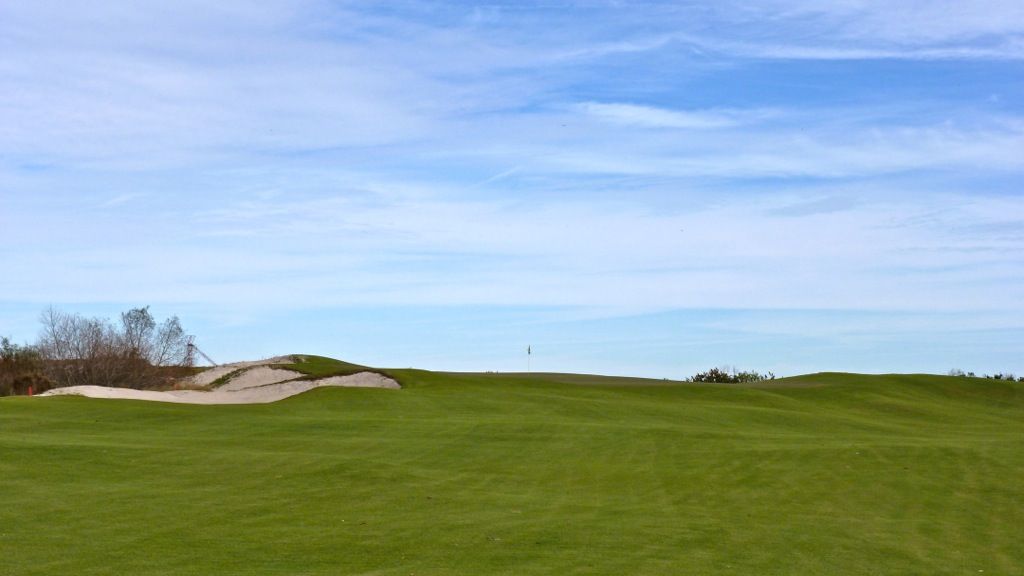
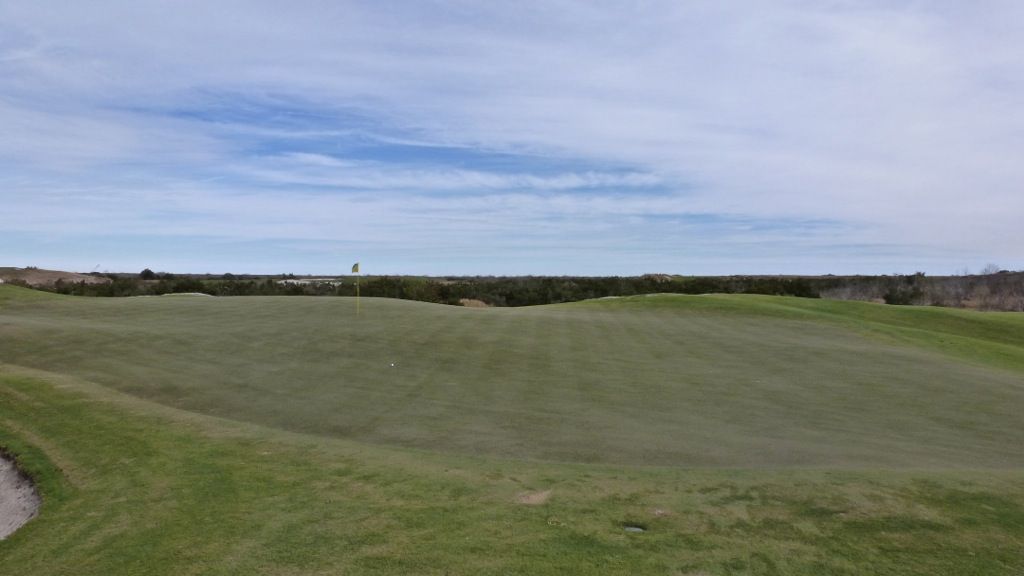
Though not as blind, the tee shot over the corner of a dune may remind some golfers of the tee shot on Ballyneal's 6th hole. With the pin in view, seemingly miles away, the temptation is strong to follow the Line of Instinct to play over/near the bunkering on the left. Those that can resist the urge to play left will find ample fairway grass to the right, and though the approach is longer from there, the angle is preferred.

Playing back into the wind (the first into the wind approach on the course), the approach on the 4th is an intimidating one with no forgiveness for a shot that misses short. Bunkering some 50 yards beyond the green serve to further intimidate, though there are acres of turf beyond the green.
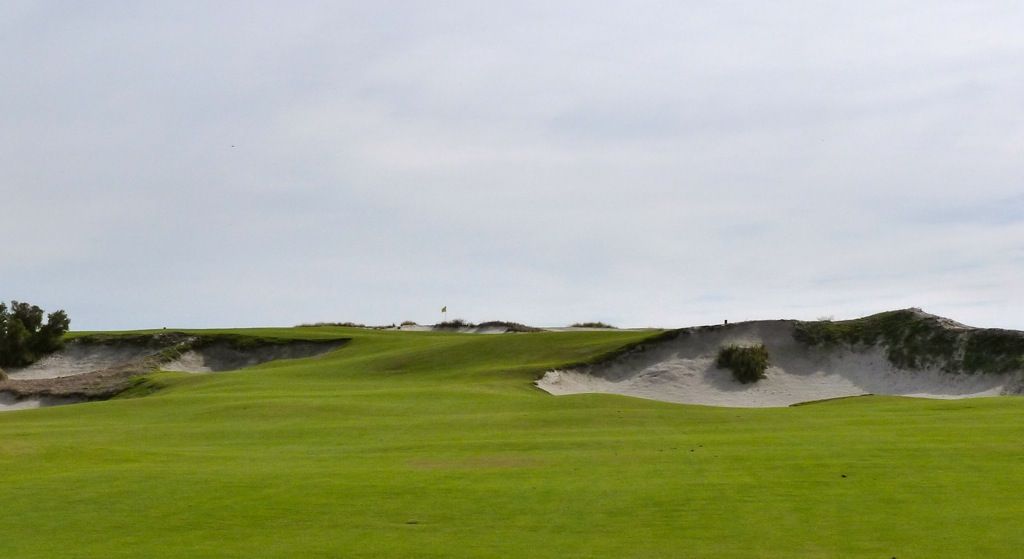
Upon cresting the hill, I was surprised at both the size and shape of this green. The green looks to be almost a perfect circle, with a single ridge cutting across it 2/3 the way back. It is also a very small target given the difficulty of the approach. From the fairway, I though the green would extend farther to the right.

Perhaps an all-world short par-3 at the 5th. 120 yards to the centre of the green (90 front, 150 back), this is a birdie hole, right? Maybe. Playing downwind to a green that falls away from the tee and with no definition on the green's left side make this is a testing proposition. Raised bunkering serves to hide a good portion of the putting surface, including the very fun pin pictured, which is set in a bowl and can be attacked many different ways.
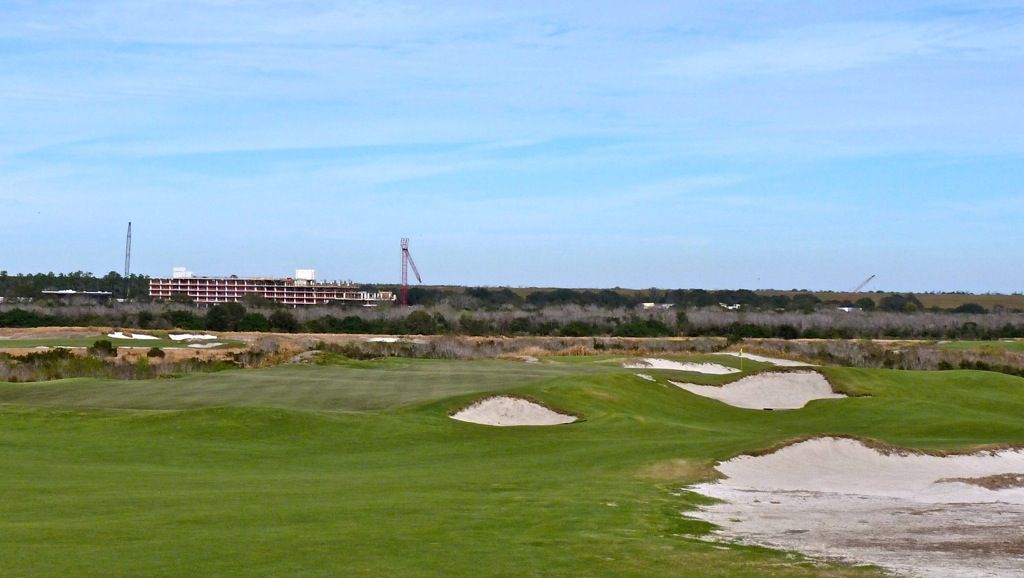
The fall-off left of the green is nerve-wracking and many golfers will steer away from it towards the bunkering. Finding a bunker is the preferred miss, as a ball landing on this very tilted fairway cut area will carom down towards the next tee leaving a testing recovery.
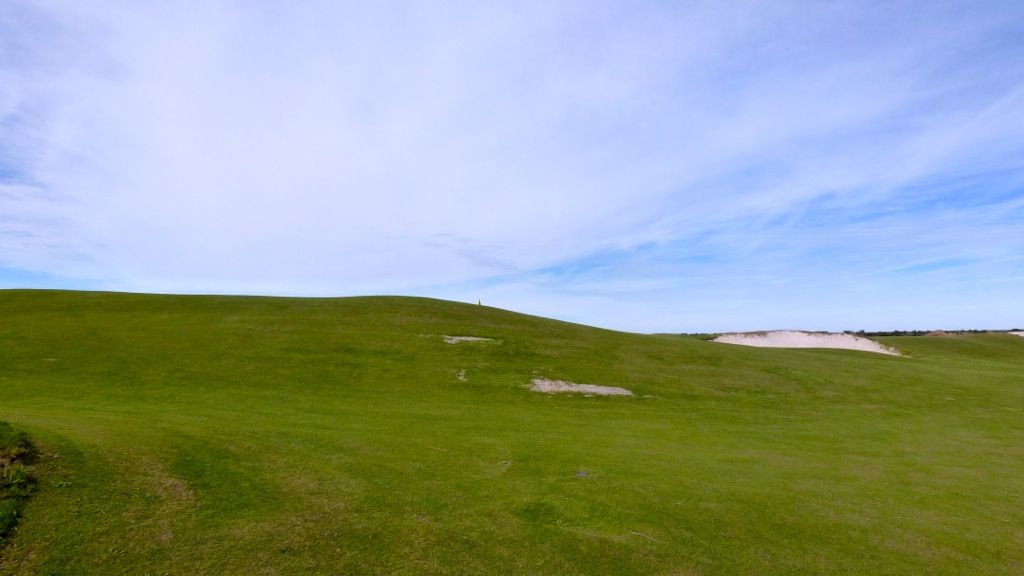
From behind the gentle rolls in the 5th green can be seen. More obvious is the front-to-back tilt.
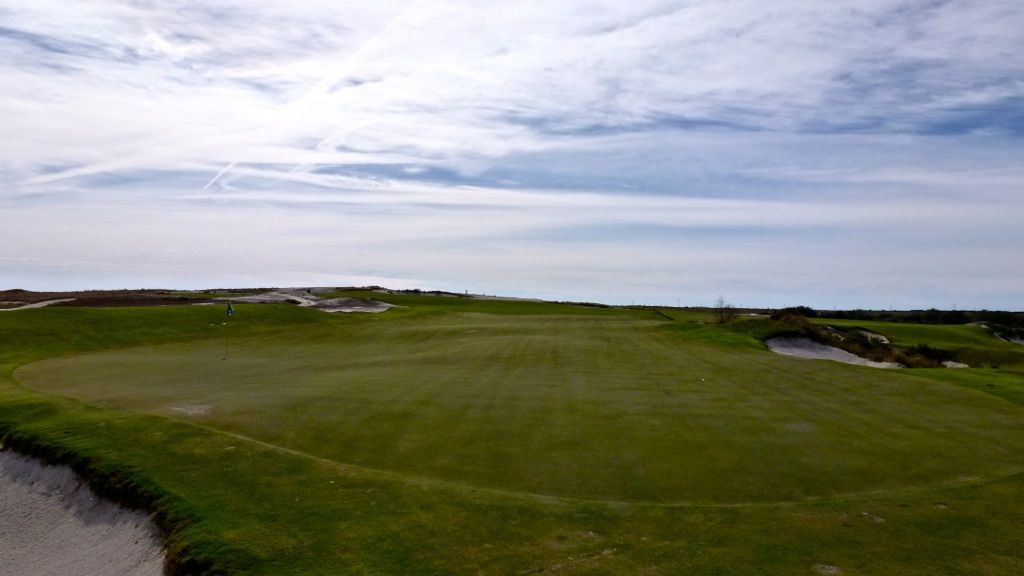
The 6th is a short par-4 that is perhaps driveable in the right wind conditions. For most, strategy will be dictated by a centreline bunker 220 yards from the Black tee.
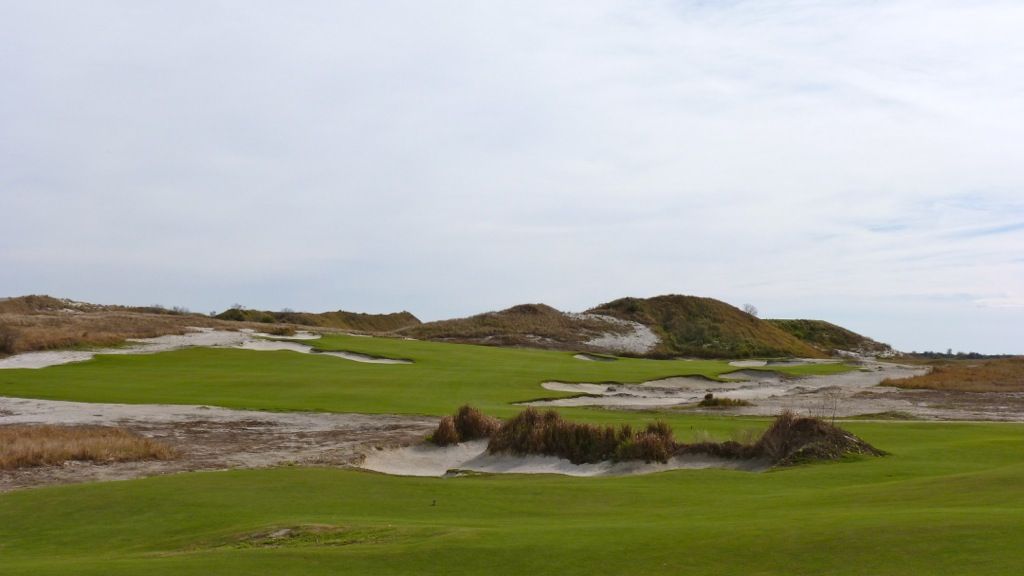
A pair of Dolly Parton-like mounds separate a right shelf in the green from the lower left portion. Only in discussion of Mike Nuzzo's Wolf Point have I seen convexity of green undulations as a topic of interest. The 6th green is one of several on the Blue that should be used in the discussion of convexity. An anecdote from my day of play: The angle/distance of approach is vital. The green dictates strategy all the way back to the tee. I played to the wide-side of the bunker. The approach from there to a right pin (which I had) must be played across the convex mounds. From the angle I played, the demand for precision is high. I hit my wedge shot a touch fat -- probably would have been a 30 foot putt if it were a flat green -- and the ball landed on the top of the mound and darted forward and left through the green, through the fairway cut and into the sandy waste area. From the appropriate angle this would not have happened.
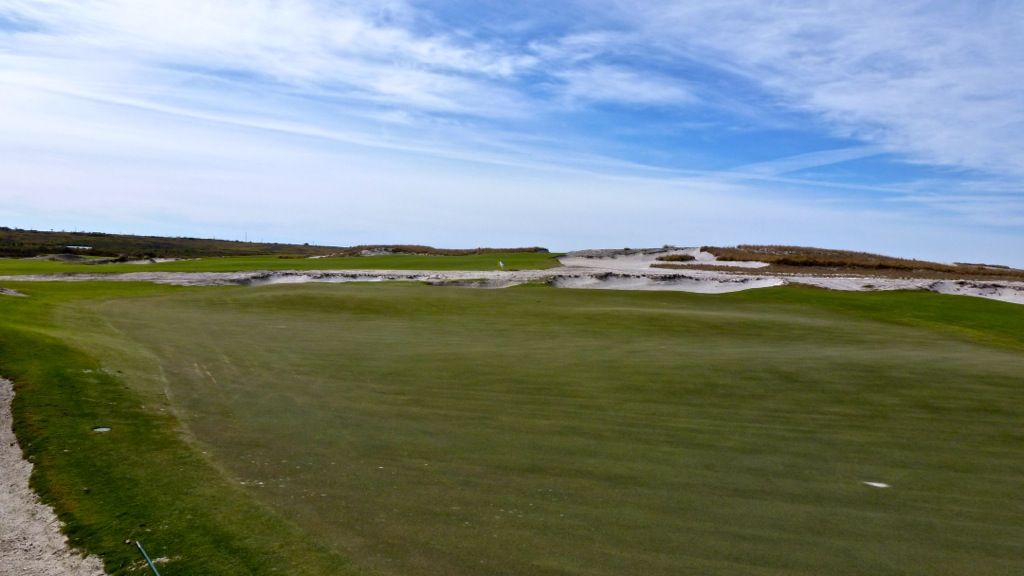
The 7th plays 190 yards from the back tees and the longer the tee played, the more difficult the angle. As mentioned earlier, some will be critical of the routing choice here as the golfer leaves his bag at the forward tee, walks to the green, and then retraces his steps. I am guessing this was not an easy choice for Doak, but an all-world green site is difficult to pass up.
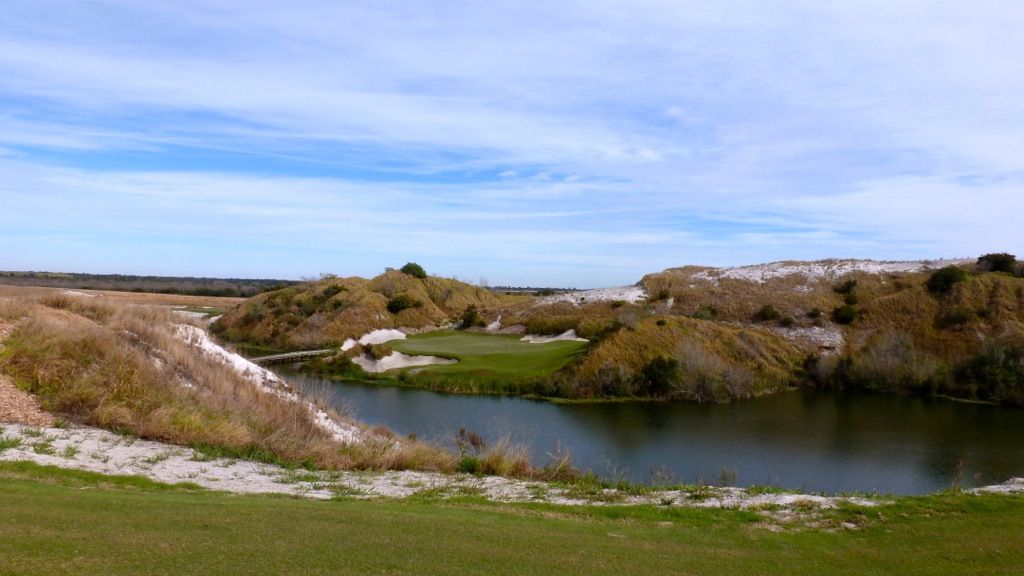

The green is filled with broad internal contours and falls from right to left with the land. Any shot landing on the left 1/4 of the green runs the risk of funnelling off the putting surface, through a run-off and into the hazard. Whereas the Blue Course seems to emphasize 'look easy, play hard,' the Red Course emphasizes the opposite, regularly offering saving bunkers and containment contouring that makes the course play easier than it looks.
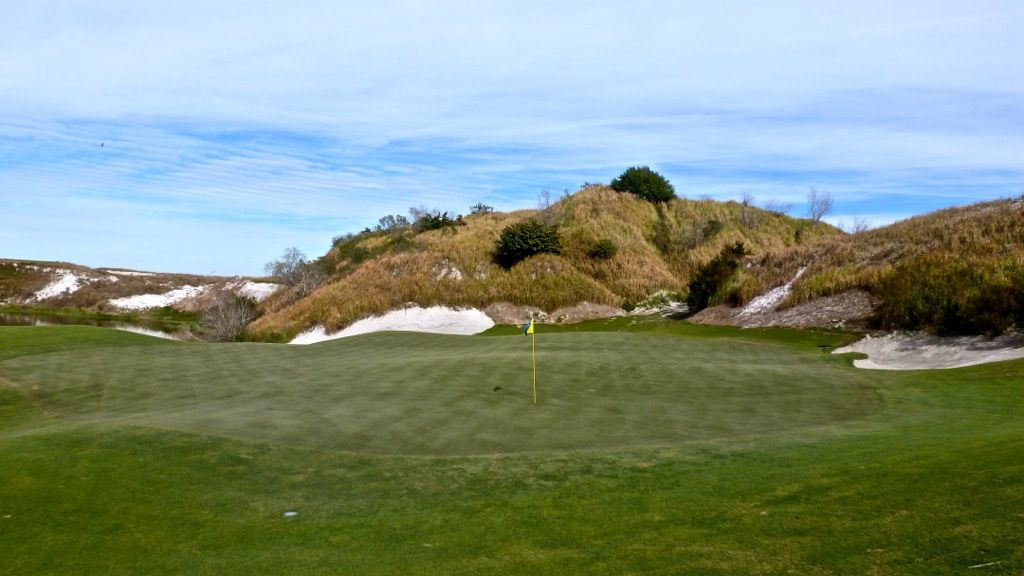
The 8th is a long par-4, but playing downwind and downhill it plays easier than the yardage indicates. Golfers playing left of the centreline bunker are rewarded with a much preferred angle of approach.
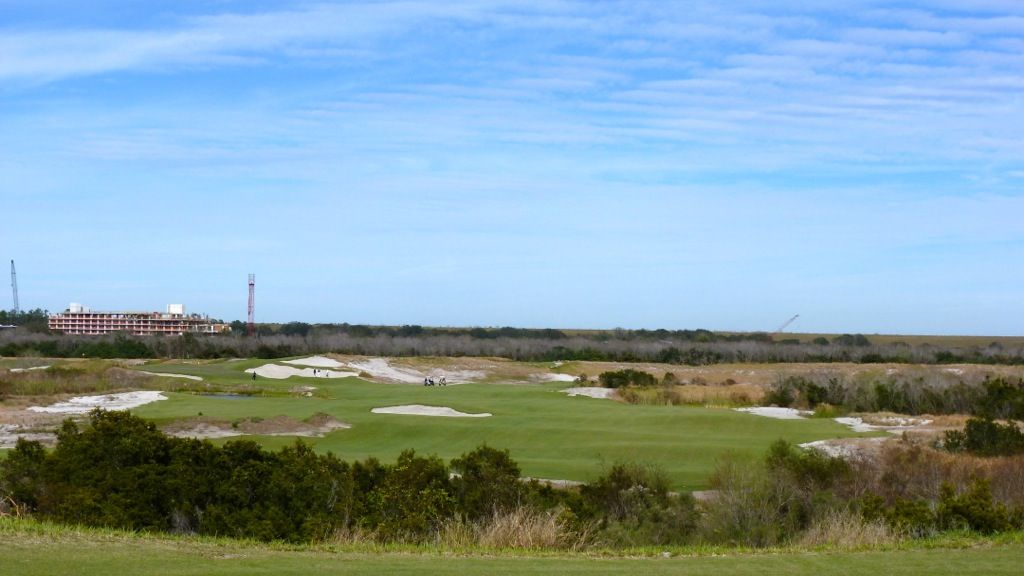

The 9th is a 575 yard par-5 that plays back into the prevailing wind. The tee shot reminds me of the 17th at Tillinghast's Somerset Hills in that the golfer is tempted to play as far right as possible, though following this temptation can get the golfer in trouble.
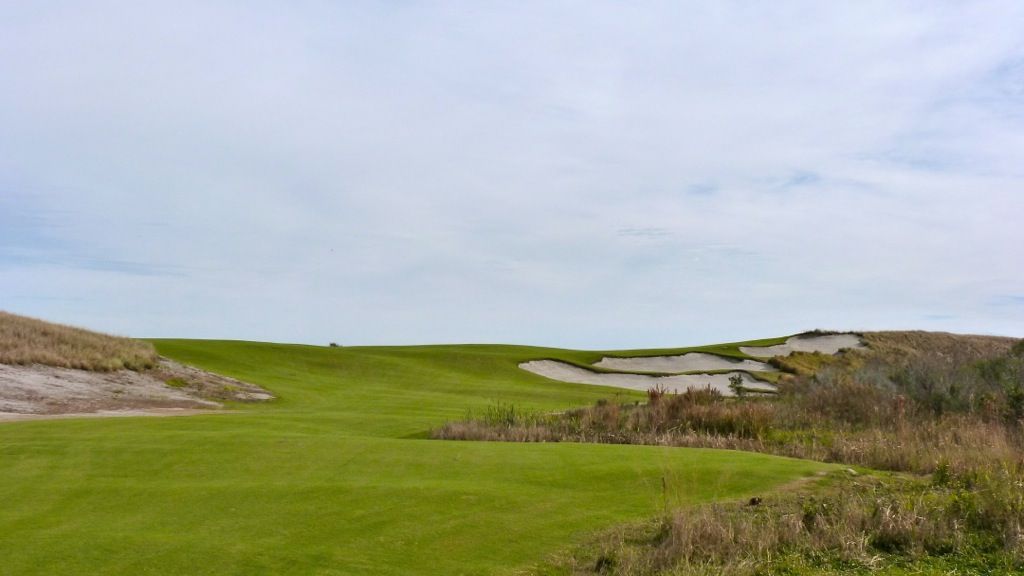
Lay-up locations will be dictated by pin position. A lay-up well to the right offers easier access to this back pin position.

The green banks hard from right to left, allowing the thinking golfer to access difficult to reach pin positions by using the backboard.
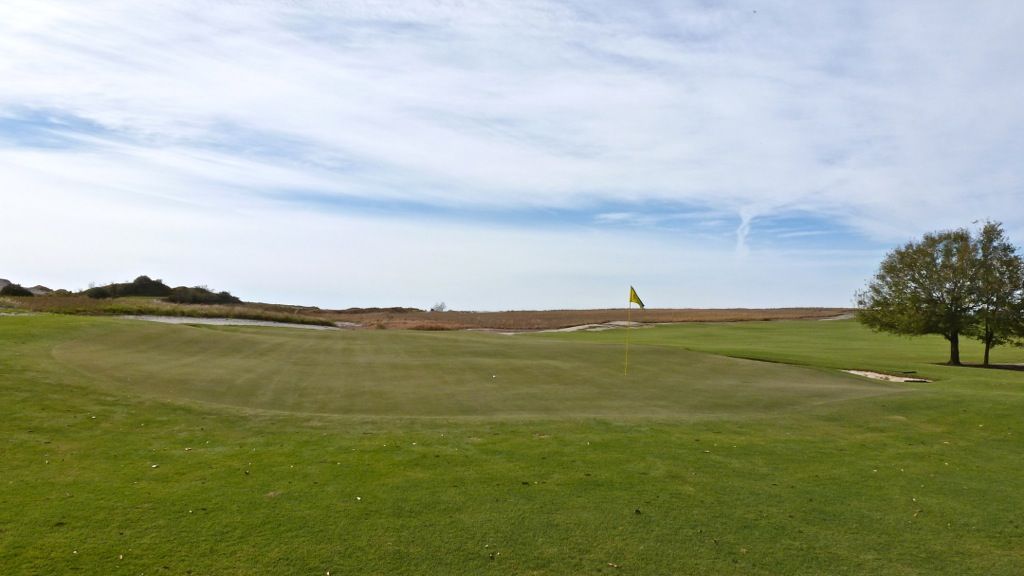
Holes 10-12 traverse the flattest part of the property. Some may call these holes less interesting, but they are where I really started to love Streamsong Blue - they are interesting but not overdone - they show tremendous restraint. The 10th hole is a 170-yard par-3 with tees that adjoin the fairway cut run-off from the 9th green. A foreshortening bunker makes depth perception a problem. The simple look of the hole may leave golfers shaking their heads when they walk off the 10th with bogies.
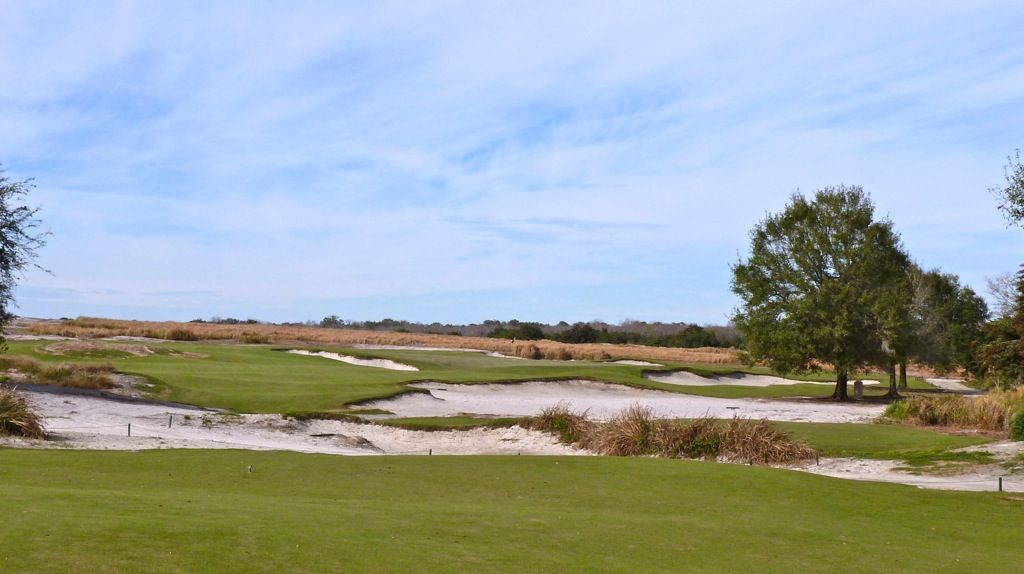
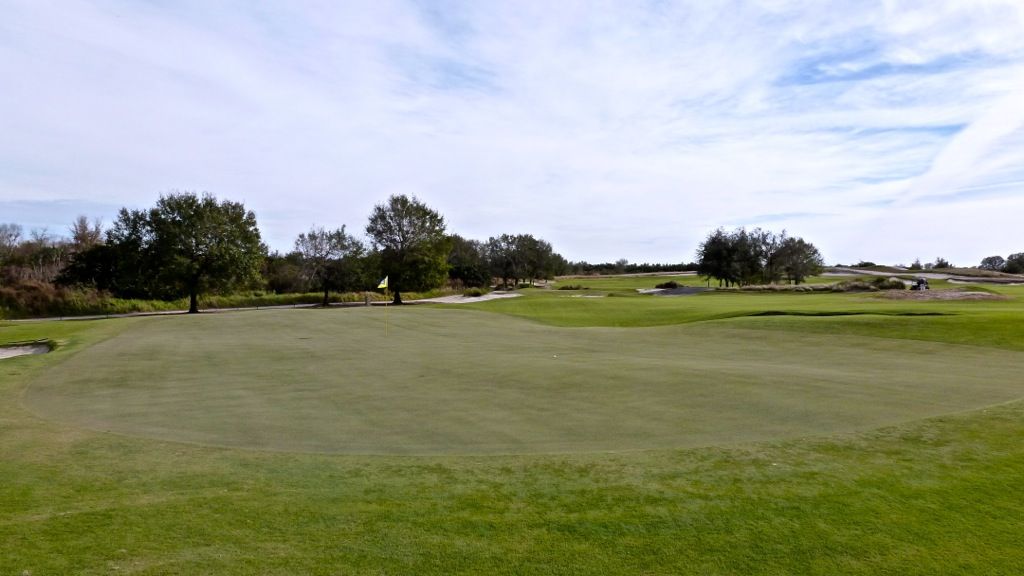
I think the 11th hole is tremendous. It is hard to describe, but the blindness of the tee shot, the pair of small centreline bunkers on an expansive fairway, the sunken and wild green and especially the gentle rolls in the fairway (which reminded me of waves in an ocean) they all combined to make a subtle elegance. I know that dirt/sand was moved everywhere, but this hole had a tremendous sense of place. It felt like a hole that was meant to be there. This 450-yard par-4 plays into the wind and is the definition of a half-par hole.
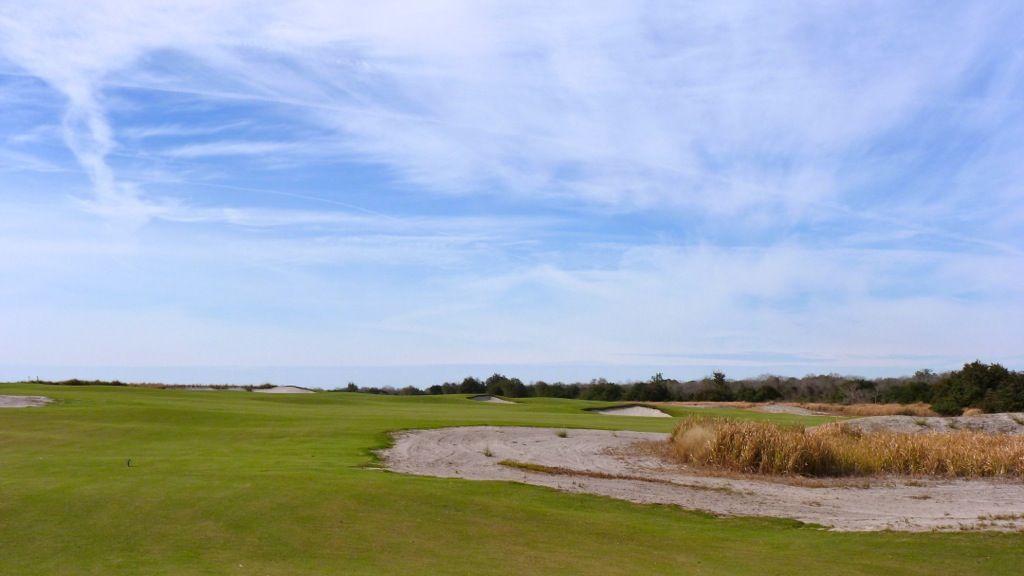
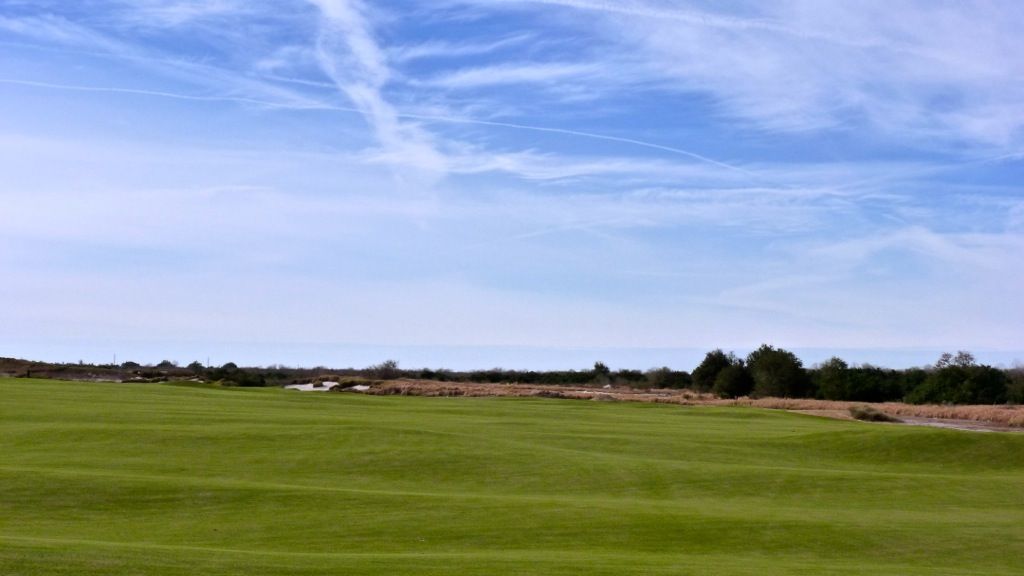
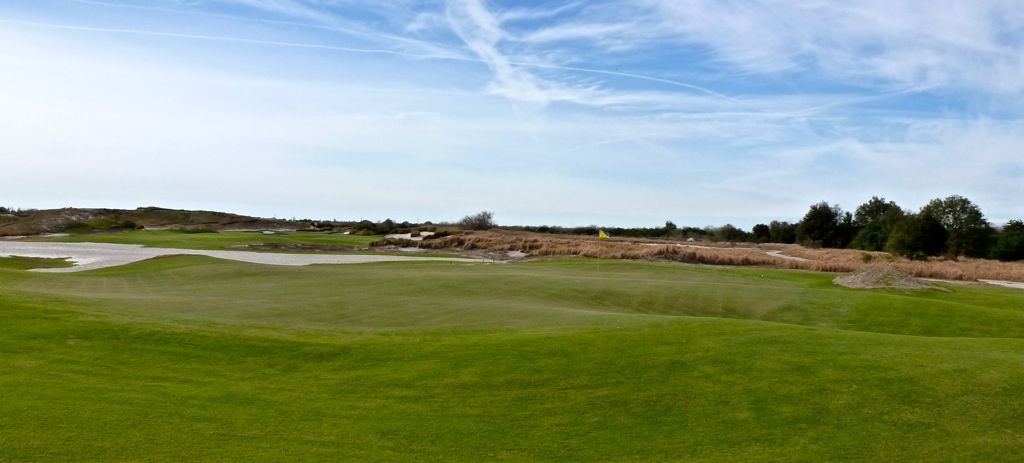
Walking of the 11th green in admiration of Doak's restraint, I was a little shocked on the 12th tee as the hole is the only one on the course where things look a little overdone. There is a lot to take in on the 12th - bunkering right, a centreline mound at 220 yards, blind fairway (?) left of the mound, the green in view - all of it combine to make a cluttered visual. Add to that the most boldly contoured green on the course and this may become a love/hate golf hole.
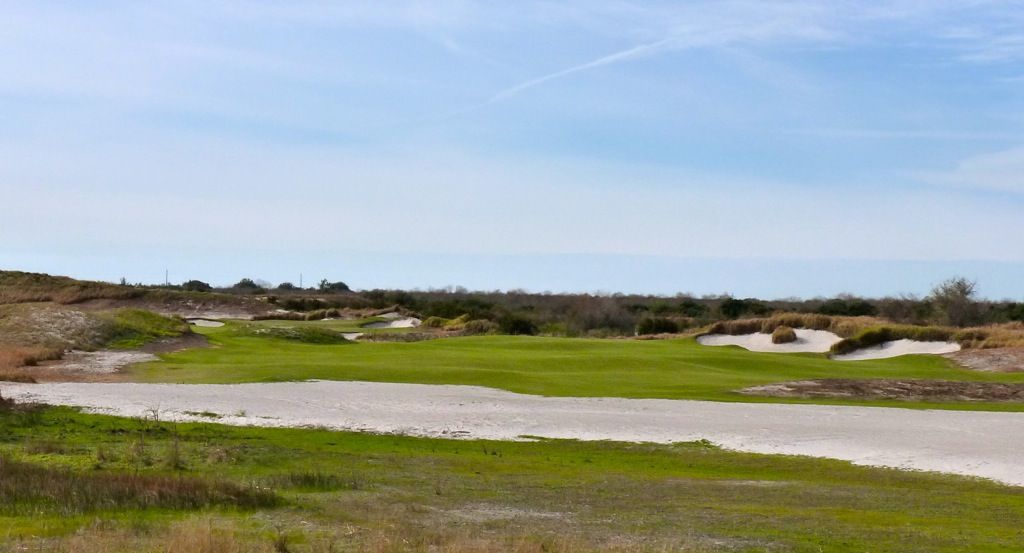
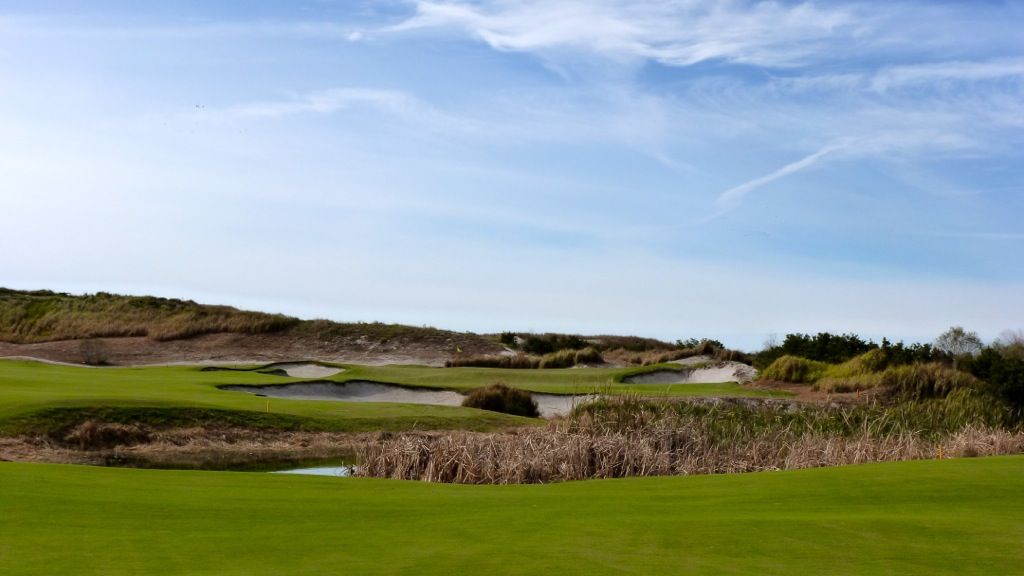
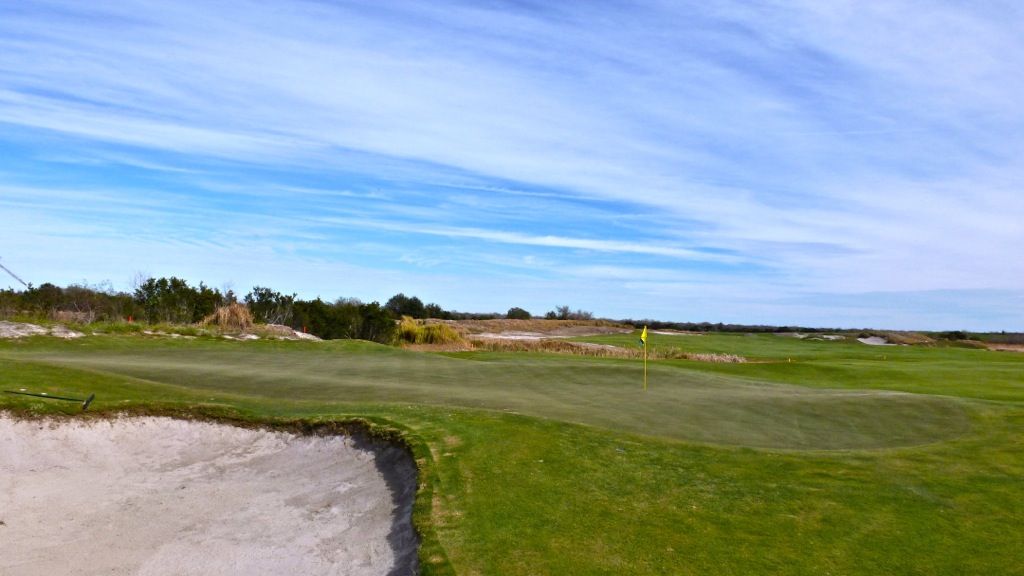
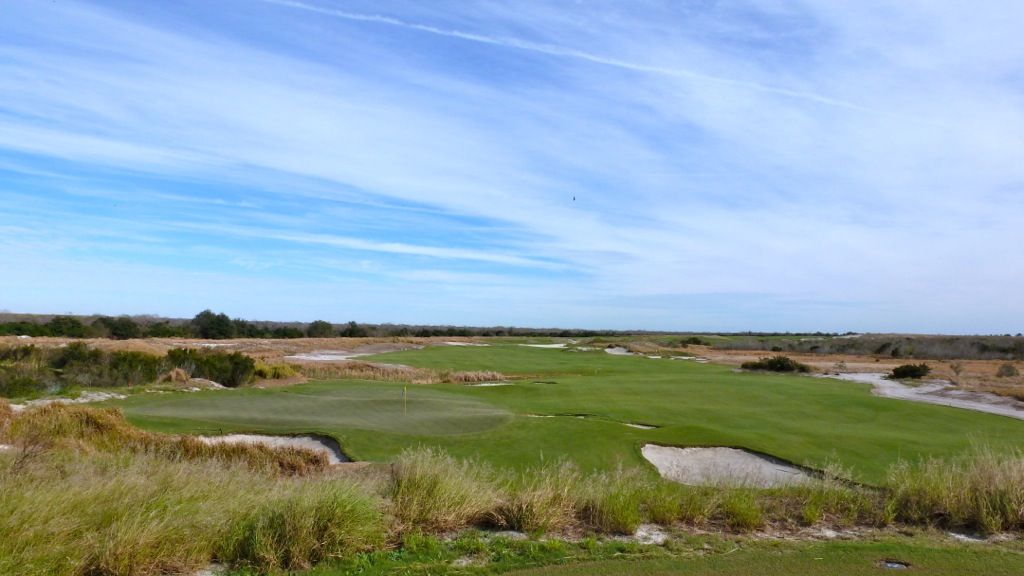
The 13th is the shortest par-4 on the back-nine playing 293 yards from the Black tees. The fairway steadily narrows the nearer the green the golfer gets and is pinched by bunkers at 200 yards on the right and 240 yards on the left. A noticeable in person (but not so noticeable in pictures) ridge splits the fairway between an upper (right) portion and a lower (left) portion. I think the 13th is a very good short par-4, but if there is a criticism it is that I'm not convinced many golfers will be tempted to 'thread the needle'. I tend to think this would always be a hybrid-SW hole for me, but repeat plays may prove that wrong.
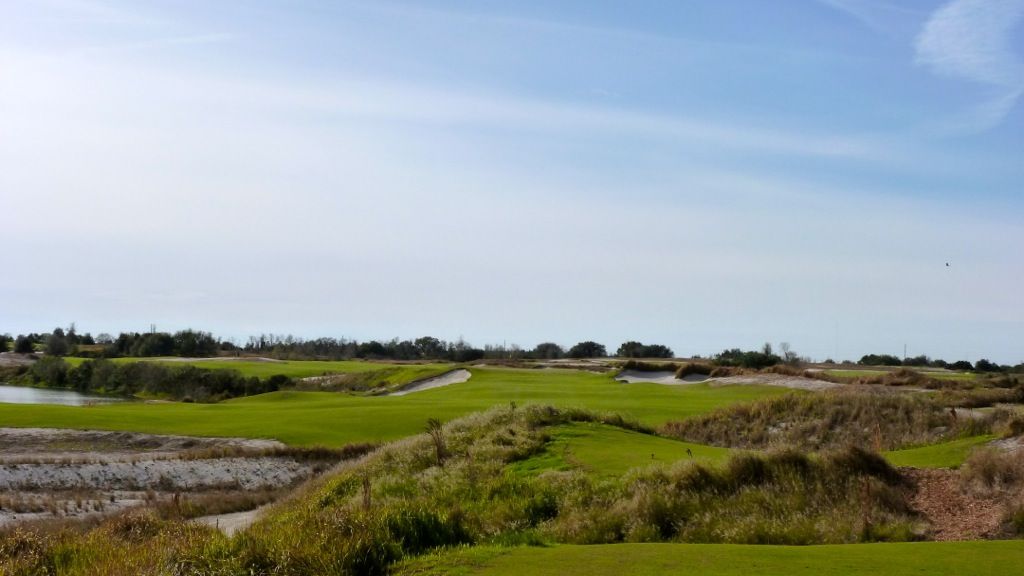
Hooking a tee shot to the lower portion of the fairway is a big mistake, arguably worse than finding the fairway bunker on the right. Shots going left will propel forward, leaving a 60-90 yard uphill pitch to a green that falls off long and right.
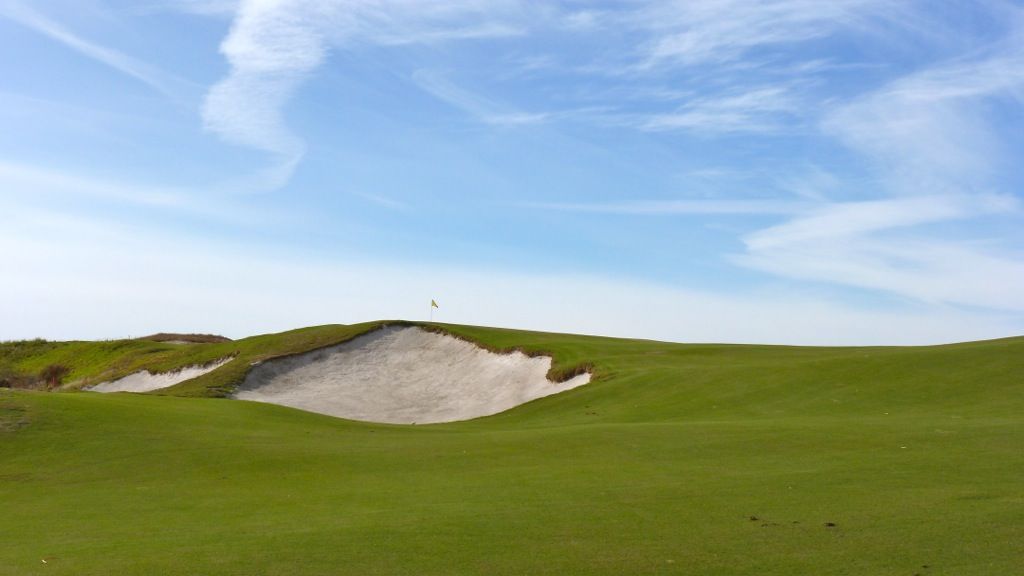
As seen from behind, the green tilts away from the line of play.
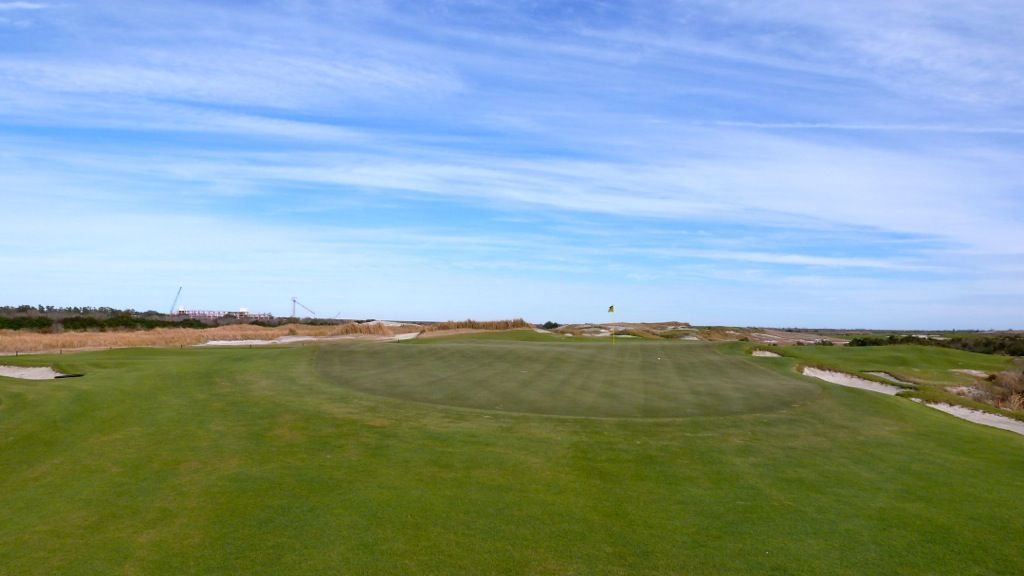
The 14th continues in the same direction as the 13th and despite its uphill nature will be reachable in two for longer hitters. Those hoping to reach the green in two will find that challenging the fairway bunkers leaves a much preferred angle of approach.
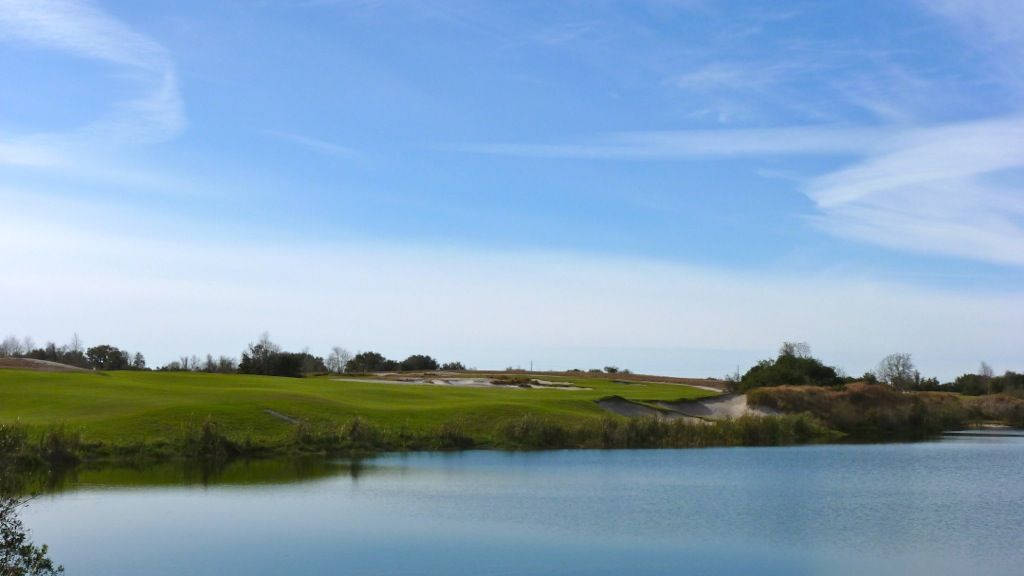
A second shot from the left-centre of the fairway shows the hazards that lay between the golfer and the green. The lay-up from here is simpler, though, and a single, small centreline bunker dictates decision-making on the second shot.
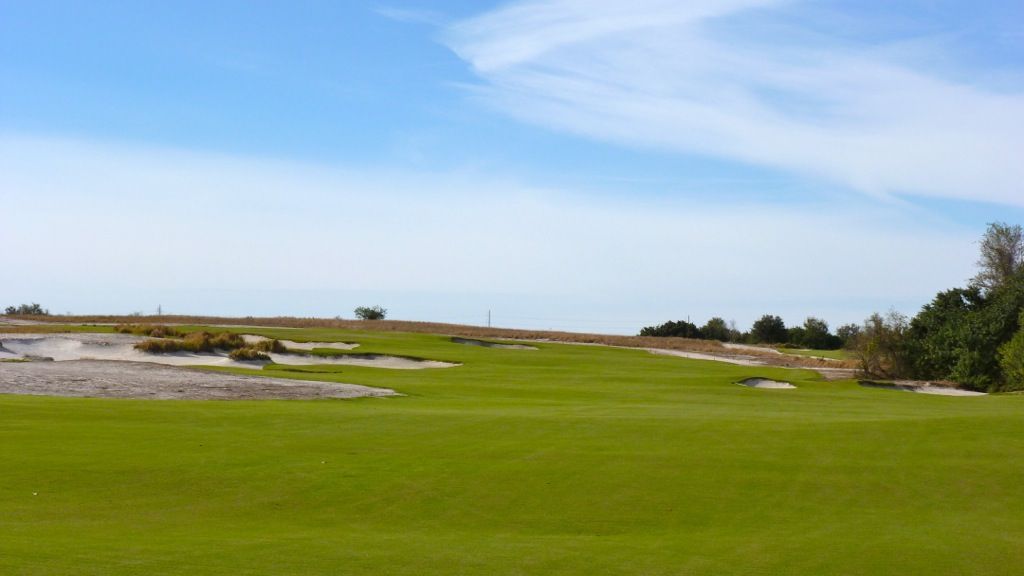
The 14th as seen from behind. Another green that ties into the external contouring flawlessly.
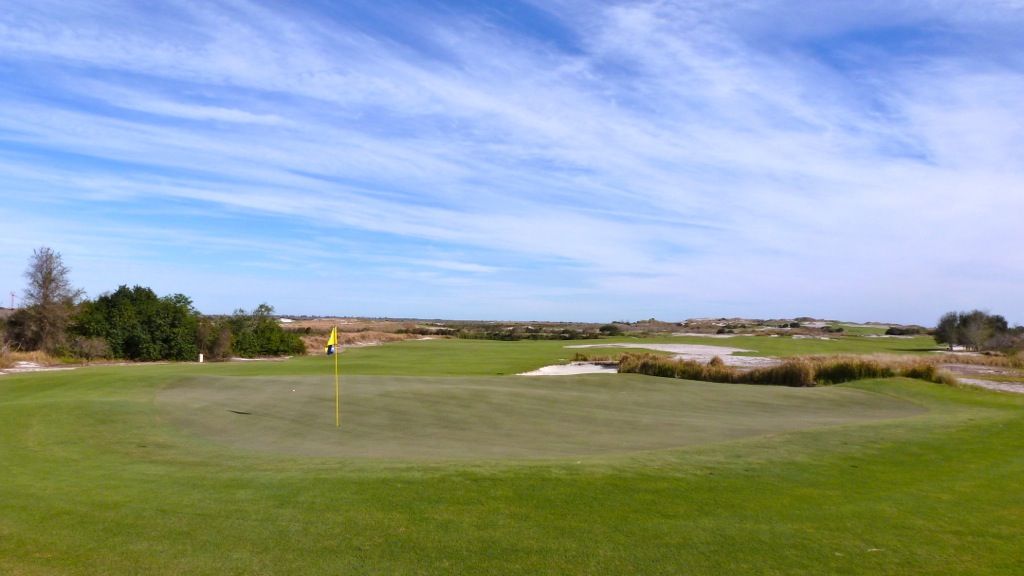
There is some visual ambiguity on the 15th tee, with the ideal line not clear to this golfer. With the wind blowing from the left and trouble to the right, it is a difficult tee shot for most righties.
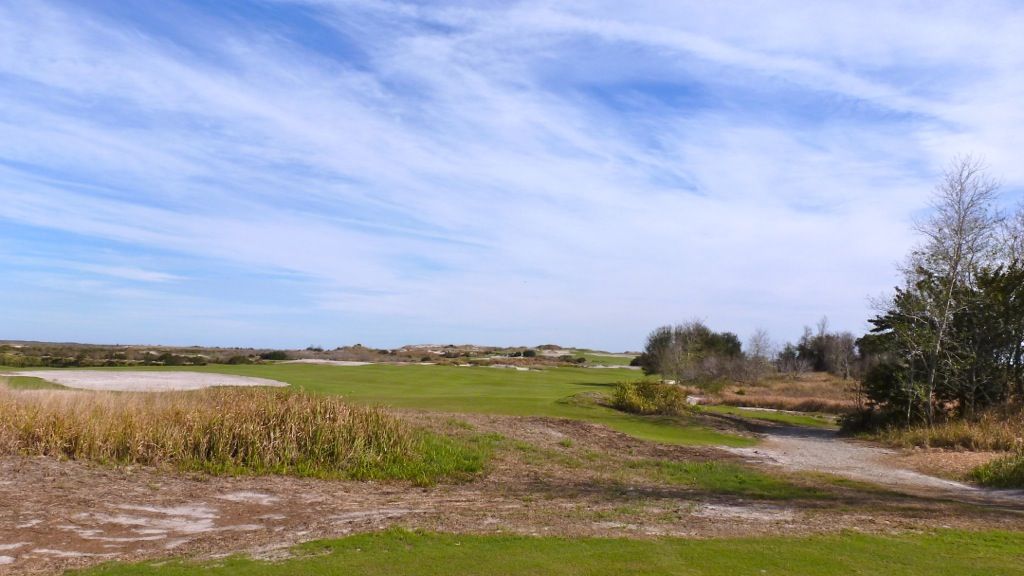
The approach is very cool. Playing to the left off the tee leaves a blind approach over an alps-like mound. The green is shallow and wide and contoured like a biarritz green turned 90 degrees.
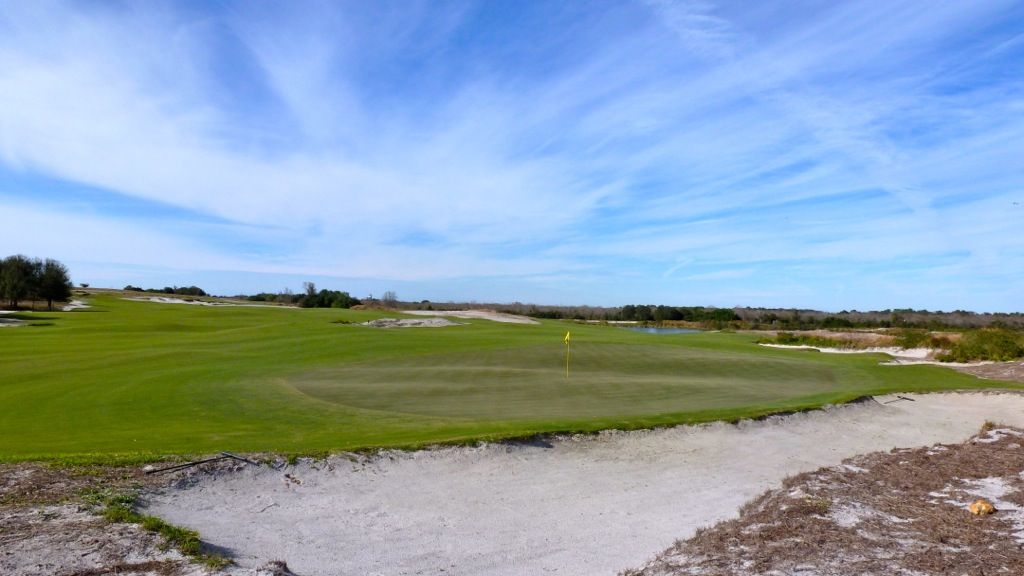
The 16th is the longest par-3 on either course, playing uphill and able to stretch to over 250 yards. A bunker eats into the green from the right side, and a series of short bunkers protect the top-shot from running onto the left portion of the green. The land, green included, slope hard from the left and the back portion of the green slopes away, making a shot directly at the target a fool's errand. Golfers choosing to play a shot landing short and left of the green will have more success.
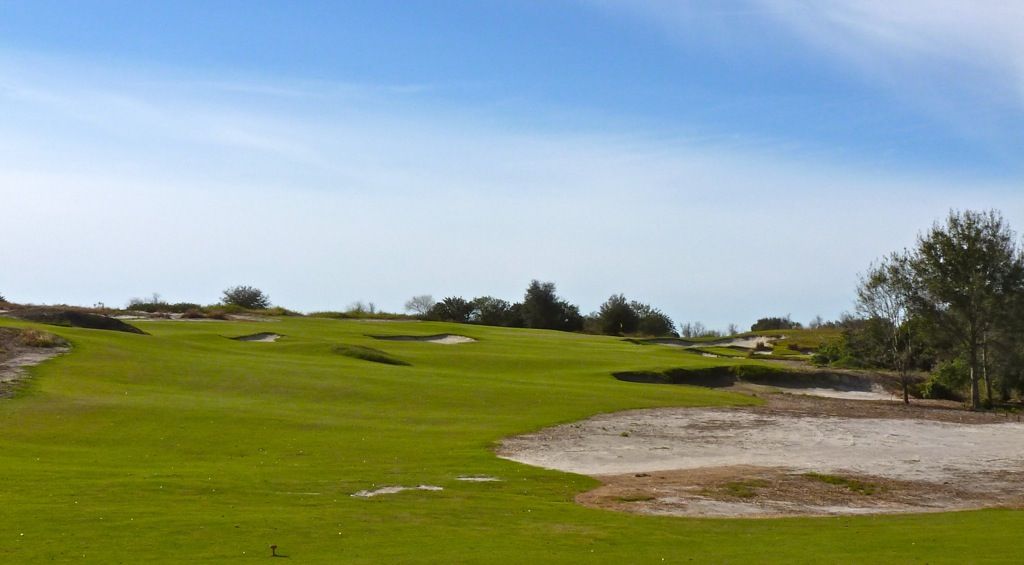

The 17th has been called Renaissance Golf Design's best par-5 -- I don't agree, I think 10 at Rock Creek is their best -- but it is nonetheless an intriguing golf hole. The tee shot is part penal, part strategic. Golfers long enough to reach this 550 yard par-5 in two may choose to attempt the 260+ yard carry over the blowout on the right to find a speed-slot and a much preferred angle into the green. Those looking to lay-up are well-served playing short of the left fairway bunker.
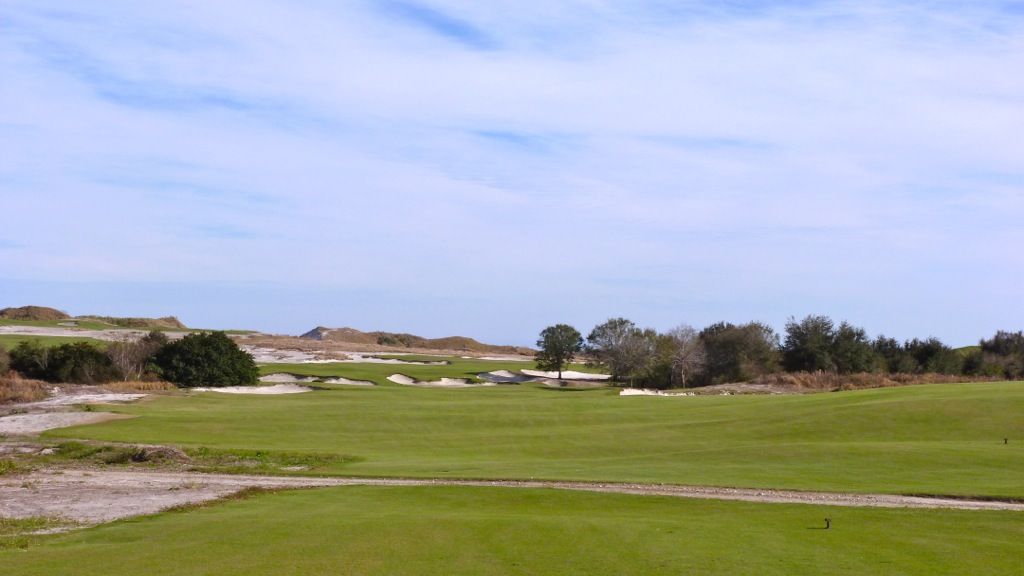
The second shot is an intimidating one, played over a series of diagonal bunkers. After a good drive I was left with only 150 yards to carry the bunkers on the shortest line, but even from the fairway it is clear that this green is best approached from the right. Playing right quickly increases the required carry yardage.
Looking at the picture below on the far right you will notice a Devil's Asshole-esque bunker behind a tree. I've called this area Doak's Double Hazard!
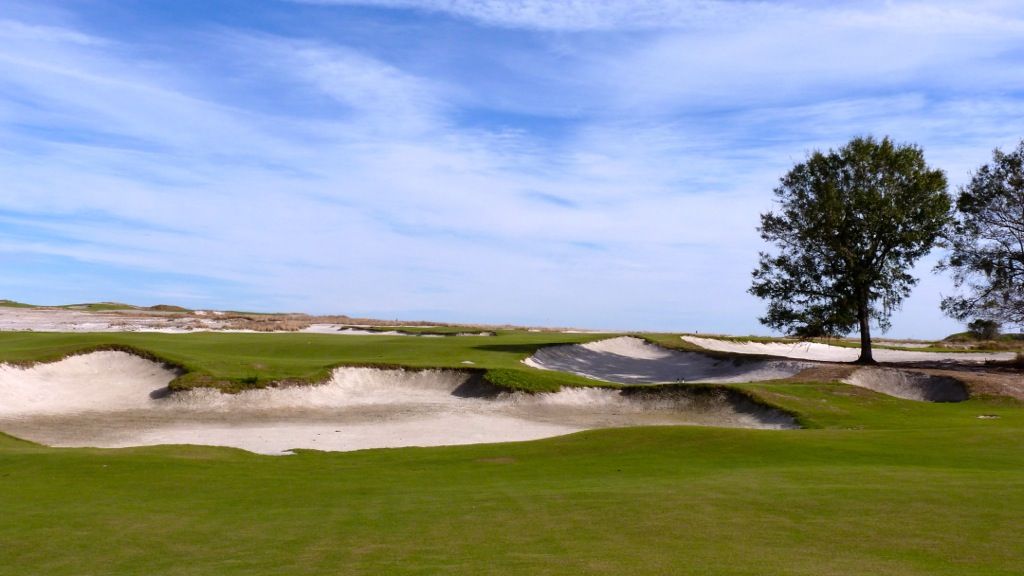
The green is two-tiered, separated by steep diagonal ridge.
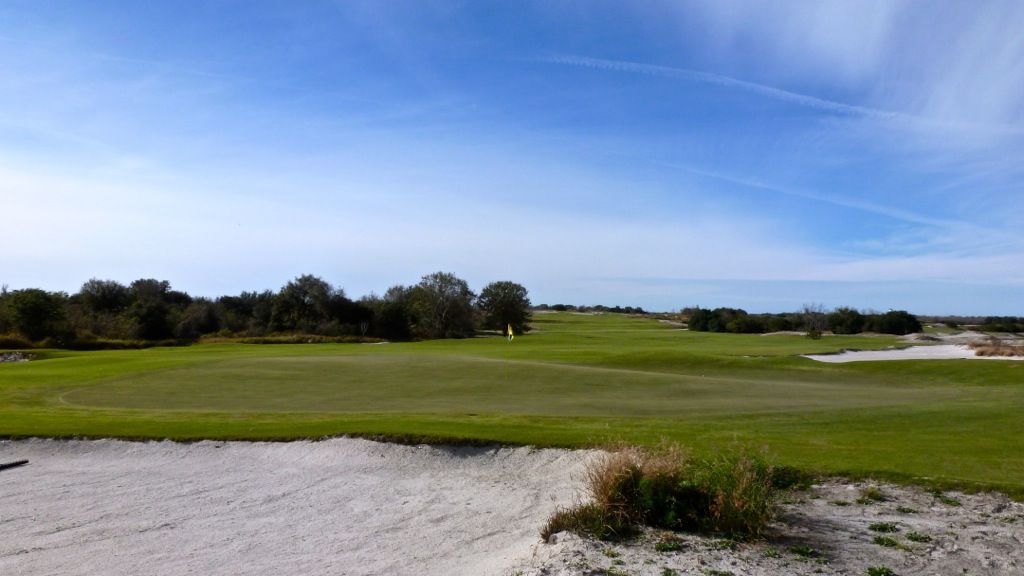
No shortage of yardage on the final three holes of the Blue, the 18th is an up and over par-4 that plays over 450 yards. The ideal line is difficult to choose from the tee, but I am guessing I will not be the only one tempted to try and carry the single centre-line bunker at about 235 yards.

Successful tee shots will either end-up here, leaving ~200 yards into the green, or they will find the speed-slot to the bottom of the hill and leave only a mid-iron in the green.

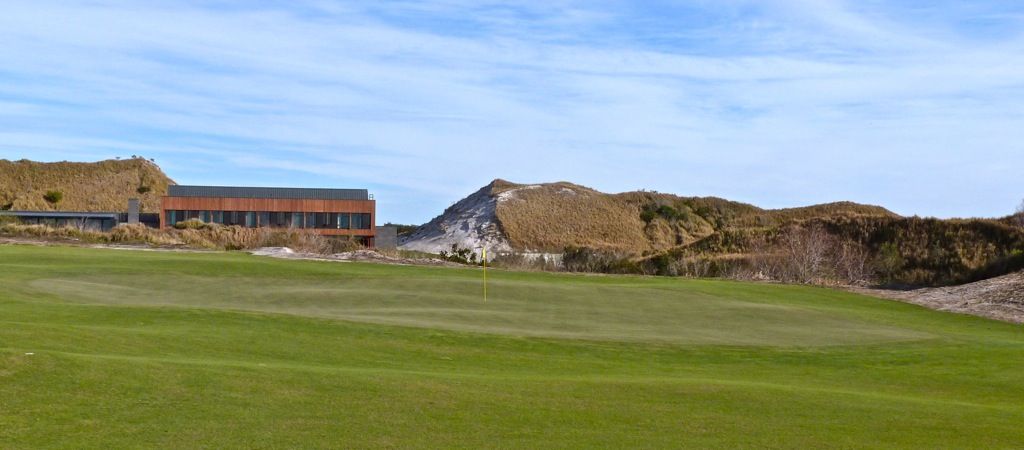
Streamsong, Florida, United States
Architect: Tom Doak (2012)
7,176 Yards, Par-72
Rating/Slope: 74.1/131
My Quick Review: Destined for top-100 world.
Tom Doak's Blue Course at Streamsong Resort is exceptional. From the first tee to the final putt, the golfer is challenged to think his way around the golf course as the direct line is rarely the ideal play. The Coore & Crenshaw Red Course is routed through larger dunes and more prevalent water hazards, perhaps making it a slightly more complicated site, but it is Doak's routing that is the more comfortable one. Doak's routing is near flawless with very short green to tee walks, constant changes in direction, and an ability to move the golfer up and down elevation with ease. The 1st tee, sited at the top of a 60 foot high (?) dune is something of a curious decision, but as Doak noted in an earlier thread the additional length was needed to prevent golfers from waiting for the first green to clear. And, the view is exceptional. The other curiosity is the decision to route the par-3 7th such that the golfer walks to the green and near back to the tee.
Tie-ins on both golf courses are perfect. Transitions from green to fairway to bunker to sandy waste area to dunes to native grasses to water hazards are so natural that one wonders whether these golf courses have been here forever.
Bunker shaping will be familiar to fans of Doak and/or Coore & Crenshaw.
Doak's greens drape perfectly on the land. There is a convexity to the undulations on some greens that is unlike anything I have ever seen before. On the Red Course, bold and broad internal contours will have misplayed shots roll slowly and steadily away from their targets. On the Blue Course, shots landing on the wrong part of the green, especially if from the wrong angle will be propelled in directions the golfer had not considered. The Red Course is overt in its penalties, the blue course subtle; but I'm not convinced the Blue Course is any easier.
Scorecard Information


Unlike the 470 yard behemoth of a par-4 on the Red, Doak eases the golfer into the round, offering the opportunity to hit less than driver from the elevated first tee. The width of the 1st fairway is probably 40 yards at its narrowest, and where the option to bailout right is available, the fairway widens to about 100 yards.

Golfers on the 1st tee help to give a sense of scale.

Aggressive tee shots down the centre/left will be rewarded with a simple pitch. Approaching from the right, though from the fairway, is a difficult task requiring a blind approach over a dune to a green that falls off on the left.


The second is a 550 yard par-5 and golfers long enough to reach this green in two will want to carry the fairway bunker (270 yards) to find a speed-slot.

Along with the 2nd shot on the par-5 9th, the 2nd shot here is one of the two dullest on the course. Those laying-up are presented with ample fairway and no obvious reason to aim anywhere but the centre. Much of the green is hidden from view behind the left bunker, though it is a miss to the right that will cause the real trouble.


The third hole starts a tremendous stretch of golf. A green set boldly on a plateau is in view from the tee and begs the golfer to play near the hazard line.

A bold tee shot up the left leaves a simple approach to a blind putting surface though shots missing the plateau right will run a very long way from the hole.


Though not as blind, the tee shot over the corner of a dune may remind some golfers of the tee shot on Ballyneal's 6th hole. With the pin in view, seemingly miles away, the temptation is strong to follow the Line of Instinct to play over/near the bunkering on the left. Those that can resist the urge to play left will find ample fairway grass to the right, and though the approach is longer from there, the angle is preferred.

Playing back into the wind (the first into the wind approach on the course), the approach on the 4th is an intimidating one with no forgiveness for a shot that misses short. Bunkering some 50 yards beyond the green serve to further intimidate, though there are acres of turf beyond the green.

Upon cresting the hill, I was surprised at both the size and shape of this green. The green looks to be almost a perfect circle, with a single ridge cutting across it 2/3 the way back. It is also a very small target given the difficulty of the approach. From the fairway, I though the green would extend farther to the right.

Perhaps an all-world short par-3 at the 5th. 120 yards to the centre of the green (90 front, 150 back), this is a birdie hole, right? Maybe. Playing downwind to a green that falls away from the tee and with no definition on the green's left side make this is a testing proposition. Raised bunkering serves to hide a good portion of the putting surface, including the very fun pin pictured, which is set in a bowl and can be attacked many different ways.

The fall-off left of the green is nerve-wracking and many golfers will steer away from it towards the bunkering. Finding a bunker is the preferred miss, as a ball landing on this very tilted fairway cut area will carom down towards the next tee leaving a testing recovery.

From behind the gentle rolls in the 5th green can be seen. More obvious is the front-to-back tilt.

The 6th is a short par-4 that is perhaps driveable in the right wind conditions. For most, strategy will be dictated by a centreline bunker 220 yards from the Black tee.

A pair of Dolly Parton-like mounds separate a right shelf in the green from the lower left portion. Only in discussion of Mike Nuzzo's Wolf Point have I seen convexity of green undulations as a topic of interest. The 6th green is one of several on the Blue that should be used in the discussion of convexity. An anecdote from my day of play: The angle/distance of approach is vital. The green dictates strategy all the way back to the tee. I played to the wide-side of the bunker. The approach from there to a right pin (which I had) must be played across the convex mounds. From the angle I played, the demand for precision is high. I hit my wedge shot a touch fat -- probably would have been a 30 foot putt if it were a flat green -- and the ball landed on the top of the mound and darted forward and left through the green, through the fairway cut and into the sandy waste area. From the appropriate angle this would not have happened.

The 7th plays 190 yards from the back tees and the longer the tee played, the more difficult the angle. As mentioned earlier, some will be critical of the routing choice here as the golfer leaves his bag at the forward tee, walks to the green, and then retraces his steps. I am guessing this was not an easy choice for Doak, but an all-world green site is difficult to pass up.


The green is filled with broad internal contours and falls from right to left with the land. Any shot landing on the left 1/4 of the green runs the risk of funnelling off the putting surface, through a run-off and into the hazard. Whereas the Blue Course seems to emphasize 'look easy, play hard,' the Red Course emphasizes the opposite, regularly offering saving bunkers and containment contouring that makes the course play easier than it looks.

The 8th is a long par-4, but playing downwind and downhill it plays easier than the yardage indicates. Golfers playing left of the centreline bunker are rewarded with a much preferred angle of approach.


The 9th is a 575 yard par-5 that plays back into the prevailing wind. The tee shot reminds me of the 17th at Tillinghast's Somerset Hills in that the golfer is tempted to play as far right as possible, though following this temptation can get the golfer in trouble.

Lay-up locations will be dictated by pin position. A lay-up well to the right offers easier access to this back pin position.

The green banks hard from right to left, allowing the thinking golfer to access difficult to reach pin positions by using the backboard.

Holes 10-12 traverse the flattest part of the property. Some may call these holes less interesting, but they are where I really started to love Streamsong Blue - they are interesting but not overdone - they show tremendous restraint. The 10th hole is a 170-yard par-3 with tees that adjoin the fairway cut run-off from the 9th green. A foreshortening bunker makes depth perception a problem. The simple look of the hole may leave golfers shaking their heads when they walk off the 10th with bogies.


I think the 11th hole is tremendous. It is hard to describe, but the blindness of the tee shot, the pair of small centreline bunkers on an expansive fairway, the sunken and wild green and especially the gentle rolls in the fairway (which reminded me of waves in an ocean) they all combined to make a subtle elegance. I know that dirt/sand was moved everywhere, but this hole had a tremendous sense of place. It felt like a hole that was meant to be there. This 450-yard par-4 plays into the wind and is the definition of a half-par hole.



Walking of the 11th green in admiration of Doak's restraint, I was a little shocked on the 12th tee as the hole is the only one on the course where things look a little overdone. There is a lot to take in on the 12th - bunkering right, a centreline mound at 220 yards, blind fairway (?) left of the mound, the green in view - all of it combine to make a cluttered visual. Add to that the most boldly contoured green on the course and this may become a love/hate golf hole.




The 13th is the shortest par-4 on the back-nine playing 293 yards from the Black tees. The fairway steadily narrows the nearer the green the golfer gets and is pinched by bunkers at 200 yards on the right and 240 yards on the left. A noticeable in person (but not so noticeable in pictures) ridge splits the fairway between an upper (right) portion and a lower (left) portion. I think the 13th is a very good short par-4, but if there is a criticism it is that I'm not convinced many golfers will be tempted to 'thread the needle'. I tend to think this would always be a hybrid-SW hole for me, but repeat plays may prove that wrong.

Hooking a tee shot to the lower portion of the fairway is a big mistake, arguably worse than finding the fairway bunker on the right. Shots going left will propel forward, leaving a 60-90 yard uphill pitch to a green that falls off long and right.

As seen from behind, the green tilts away from the line of play.

The 14th continues in the same direction as the 13th and despite its uphill nature will be reachable in two for longer hitters. Those hoping to reach the green in two will find that challenging the fairway bunkers leaves a much preferred angle of approach.

A second shot from the left-centre of the fairway shows the hazards that lay between the golfer and the green. The lay-up from here is simpler, though, and a single, small centreline bunker dictates decision-making on the second shot.

The 14th as seen from behind. Another green that ties into the external contouring flawlessly.

There is some visual ambiguity on the 15th tee, with the ideal line not clear to this golfer. With the wind blowing from the left and trouble to the right, it is a difficult tee shot for most righties.

The approach is very cool. Playing to the left off the tee leaves a blind approach over an alps-like mound. The green is shallow and wide and contoured like a biarritz green turned 90 degrees.

The 16th is the longest par-3 on either course, playing uphill and able to stretch to over 250 yards. A bunker eats into the green from the right side, and a series of short bunkers protect the top-shot from running onto the left portion of the green. The land, green included, slope hard from the left and the back portion of the green slopes away, making a shot directly at the target a fool's errand. Golfers choosing to play a shot landing short and left of the green will have more success.


The 17th has been called Renaissance Golf Design's best par-5 -- I don't agree, I think 10 at Rock Creek is their best -- but it is nonetheless an intriguing golf hole. The tee shot is part penal, part strategic. Golfers long enough to reach this 550 yard par-5 in two may choose to attempt the 260+ yard carry over the blowout on the right to find a speed-slot and a much preferred angle into the green. Those looking to lay-up are well-served playing short of the left fairway bunker.

The second shot is an intimidating one, played over a series of diagonal bunkers. After a good drive I was left with only 150 yards to carry the bunkers on the shortest line, but even from the fairway it is clear that this green is best approached from the right. Playing right quickly increases the required carry yardage.
Looking at the picture below on the far right you will notice a Devil's Asshole-esque bunker behind a tree. I've called this area Doak's Double Hazard!

The green is two-tiered, separated by steep diagonal ridge.

No shortage of yardage on the final three holes of the Blue, the 18th is an up and over par-4 that plays over 450 yards. The ideal line is difficult to choose from the tee, but I am guessing I will not be the only one tempted to try and carry the single centre-line bunker at about 235 yards.

Successful tee shots will either end-up here, leaving ~200 yards into the green, or they will find the speed-slot to the bottom of the hill and leave only a mid-iron in the green.


Subscribe to:
Comments (Atom)
